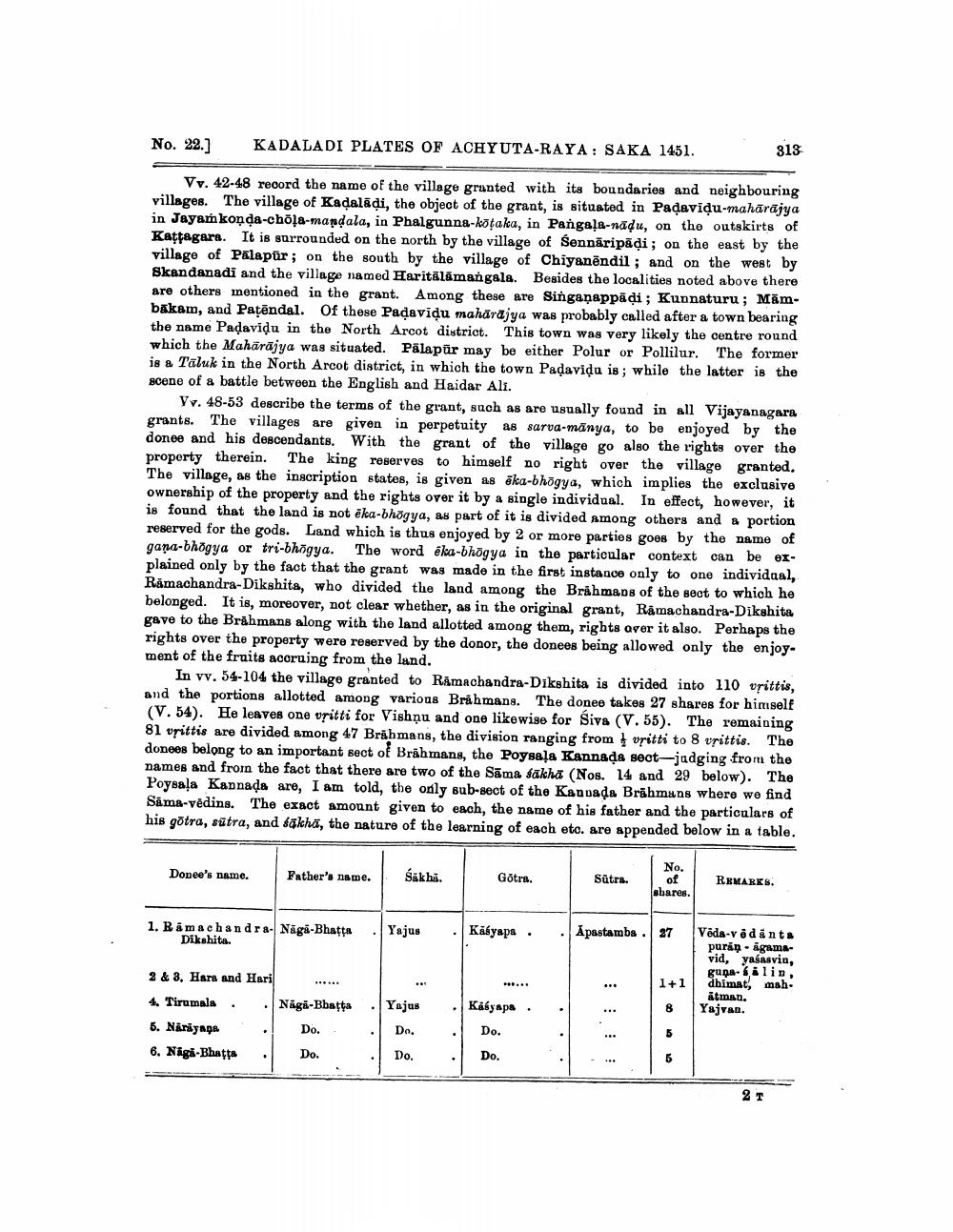________________
No. 22.]
KADALADI PLATES OF ACHYUTA-RAYA: SAKA 1451.
Vv. 42-48 record the name of the village granted with its boundaries and neighbouring villages. The village of Kadalaḍi, the object of the grant, is situated in Padaviḍu-mahārājya in Jayamkonda-chola-mandala, in Phalgunna-kōṭaka, in Pangala-nadu, on the outskirts of Kattagara. It is surrounded on the north by the village of Sennaripaḍi; on the east by the village of Pälapur; on the south by the village of Chiyanendil; and on the west by Skandanadi and the village named Haritalamangala. Besides the localities noted above there are others mentioned in the grant. Among these are Singaṇappadi; Kunnaturu; Māmbākam, and Paṭēndal. Of these Paḍaviḍu maharajya was probably called after a town bearing the name Padaviḍu in the North Arcot district. This town was very likely the centre round which the Maharajya was situated. Pälapur may be either Polur or Pollilur. The former is a Taluk in the North Arcot district, in which the town Padavidu is; while the latter is the scene of a battle between the English and Haidar Ali.
Vv. 48-53 describe the terms of the grant, such as are usually found in all Vijayanagara grants. The villages are given in perpetuity as sarva-manya, to be enjoyed by the donee and his descendants. With the grant of the village go also the rights over the property therein. The king reserves to himself no right over the village granted. The village, as the inscription states, is given as eka-bhōgya, which implies the exclusive ownership of the property and the rights over it by a single individual. In effect, however, it is found that the land is not eka-bhogya, as part of it is divided among others and a portion reserved for the gods. Land which is thus enjoyed by 2 or more parties goes by the name of gana-bhogya or tri-bhagya. The word eka-bhögya in the particular context can be explained only by the fact that the grant was made in the first instance only to one individual, Ramachandra-Dikshita, who divided the land among the Brahmans of the sect to which he belonged. It is, moreover, not clear whether, as in the original grant, Ramachandra-Dikshita gave to the Brahmans along with the land allotted among them, rights over it also. Perhaps the rights over the property were reserved by the donor, the donees being allowed only the enjoyment of the fruits accruing from the land.
In vv. 54-104 the village granted to Ramachandra-Dikshita is divided into 110 vṛittis, and the portions allotted among various Brahmans. The donee takes 27 shares for himself (V. 54). He leaves one vritti for Vishnu and one likewise for Siva (V. 55). The remaining 81 vrittis are divided among 47 Brähmans, the division ranging from vritti to 8 vrittis. The donees belong to an important sect of Brahmans, the Poysala Kannada sect-judging from the names and from the fact that there are two of the Sama sakha (Nos. 14 and 29 below). The Poysala Kannada are, I am told, the only sub-sect of the Kannada Brahmans where we find Sama-vēdins. The exact amount given to each, the name of his father and the particulars of his gōtra, sutra, and sakha, the nature of the learning of each etc. are appended below in a table.
Donee's name.
Father's name.
2 & 3. Hara and Hari
4. Tirumala
5. Nārāyana
6. Naga-Bhatta
1. Ramachandra Naga-Bhatta Yajus Dikshita.
śākhā.
Naga-Bhatta
Do.
Do.
Yajus
Do.
Do.
Götra.
Kasyapa.
Kasyapa
Do.
Do.
•
Sütra.
No. of shares.
Apastamba. 27
1+1
8
5
5
313
REMARKS.
Veda-vedants puran agamavid, yasasvin, guna-lin, dhimat, mahätman. Yajvan.
2 T




